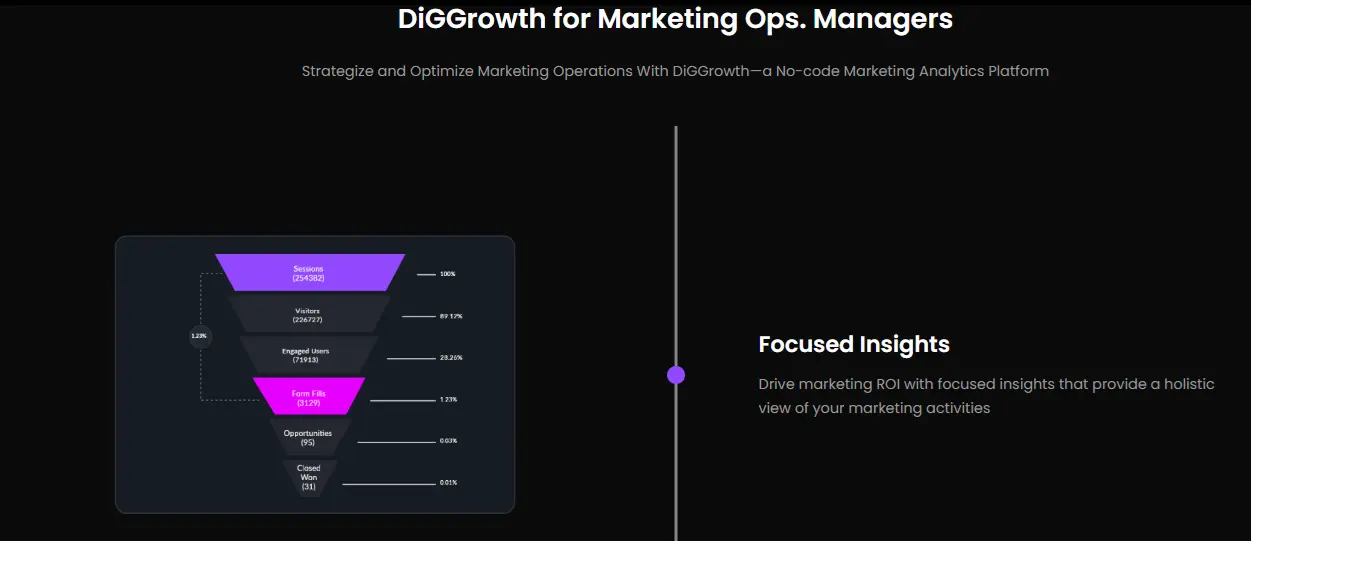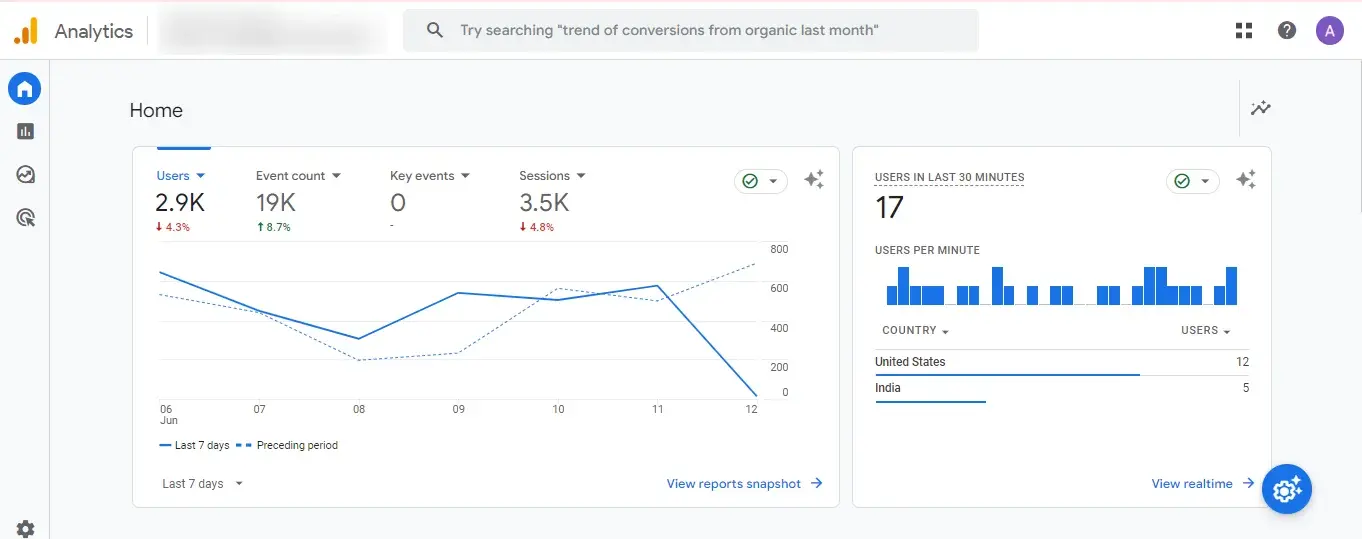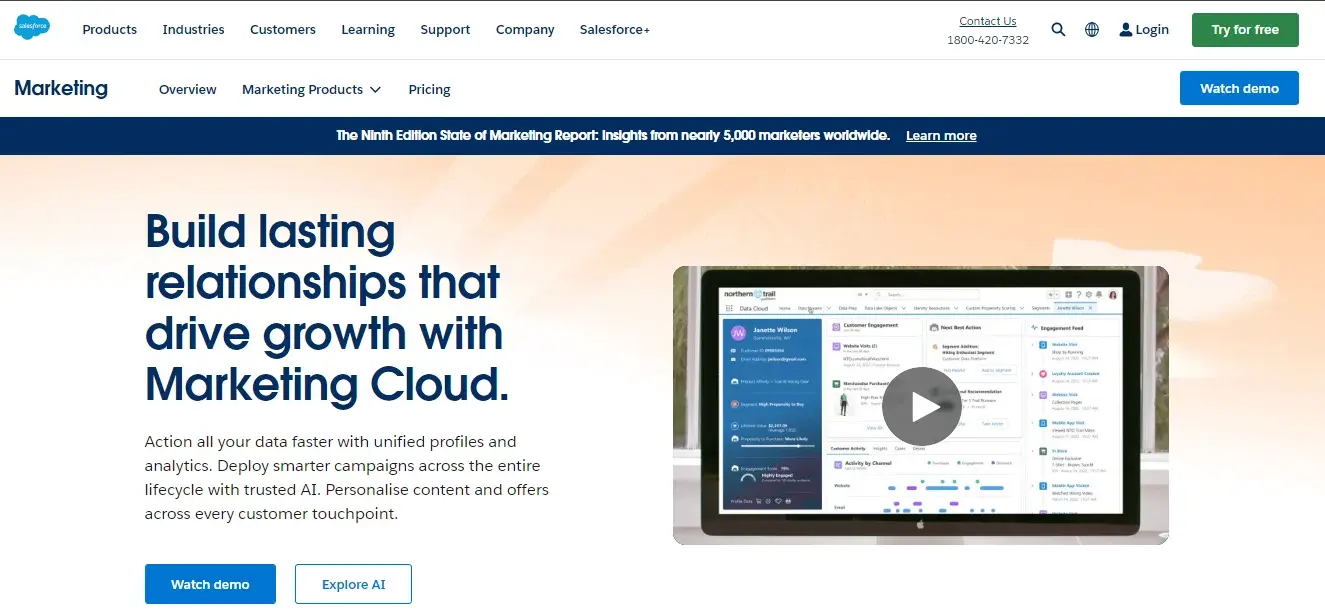Marketing Campaign Tracker: Your One-Stop Shop for Marketing Success
Are you struggling to measure marketing campaign performance and optimize strategies? This comprehensive guide explores the power of marketing campaign trackers, empowering you to set clear goals, track KPIs, leverage real-time data, unify multichannel tracking, and utilize A/B testing for continuous improvement. Discover how to calculate ROI, make strategic budget allocations, and unlock marketing success through a data-driven approach.
A marketing campaign comprises a strategic execution of promotional activities to drive engagement, create awareness, and boost product or service sales. Tailoring content to targeted audiences, harnessing diverse media channels, and deploying research-based timing is integral to designing an effective campaign. Ensuring success requires real-time monitoring and analysis, hence deploying a marketing campaign tracker.
This dynamic tool navigates the complexity of marketing strategies, capturing crucial data points and delivering insight that drives informed decisions. The project tracker is the compass that guides marketing professionals through the journey from campaign inception to fruition, providing visibility into every nuance affecting campaign performance.
What Does It Mean to Track a Marketing Campaign?
Tracking a marketing campaign involves collecting and analyzing data from multiple touchpoints to assess performance and effectiveness. It helps marketers understand which strategies drive engagement, conversions, and revenue. By monitoring key metrics, businesses can refine their approach, allocate budgets effectively, and improve return on investment.
Reasons to Track Marketing Campaigns
Tracking marketing campaigns is essential for making data-driven decisions and maximizing returns. The right marketing campaign tracking software helps businesses monitor key metrics, optimize strategies, and improve overall campaign effectiveness. Here are key reasons why campaign tracking is crucial:
- Measure Performance: Evaluate the success of different marketing efforts by analyzing engagement, conversions, and revenue generation.
- Optimize Budget Allocation: Identify high-performing channels and allocate resources to maximize impact.
- Enhance Customer Targeting: Understand audience behavior and preferences to refine messaging and personalization.
- Improve Campaign Effectiveness: Use real-time data to adjust strategies, improve engagement, and boost conversion rates.
- Prove ROI: Justify marketing investments by measuring returns and optimizing future campaigns.
10 Ways to Track Marketing Campaigns
Tracking marketing campaigns requires a combination of tools and strategies to measure performance accurately. Effective campaign performance tracking helps businesses analyze engagement, conversions, and customer behavior, ensuring data-driven decision-making for optimizing marketing efforts. Here are ten effective ways to monitor and optimize your campaigns:
- UTM Parameters:
- Google Analytics:
- CRM Software:
- Marketing Automation Tools:
- Social Media Analytics:
- Call Tracking Software:
- Pixel Tracking:
- Affiliate and Referral Tracking:
- A/B Testing:
- Custom Dashboards:
Add UTM tags to campaign URLs to track traffic sources, mediums, and specific marketing efforts in Google Analytics. This helps identify which platforms drive the most engagement and conversions.
Use Google Analytics to monitor website traffic, bounce rates, session durations, and conversion paths. Set up goals and funnels to track users’ interactions with your campaign assets.
Integrate a CRM system like Salesforce or HubSpot to track leads, customer interactions, and conversion journeys. This enables better attribution of marketing efforts to actual sales.
Platforms like HubSpot, Marketo, or Pardot offer tracking for email campaigns, lead nurturing, and customer touchpoints, helping marketers understand engagement levels and optimize workflows.
Use built-in analytics from platforms like Facebook Insights, LinkedIn Analytics, and Twitter Analytics to measure impressions, clicks, shares, and audience demographics. This helps fine-tune content strategies.
Use tools like CallRail or Call Tracking Metrics to assign unique phone numbers to different marketing campaigns. This helps track offline conversions, and attribute leads to specific campaigns.
Install tracking pixels from platforms like Meta (Facebook) and Google Ads to monitor user interactions, ad performance, and retarget website visitors with relevant offers.
Use affiliate tracking software or unique referral codes to monitor partner-driven sales. This ensures accurate commission payouts and helps assess the performance of referral programs.
Run A/B tests on ad creatives, email subject lines, landing pages, and CTAs to determine which versions generate the highest engagement and conversion rates. Tools like Google Optimize or Optimizely can facilitate testing.
Use business intelligence tools like Google Data Studio, Tableau, or Power BI to consolidate data from multiple marketing channels. This provides a real-time view of campaign performance and helps make data-driven decisions.
Setting up Key Performance Indicators (KPIs)
Key Performance Indicators (KPIs) are the compass for marketing campaigns, guiding marketers toward their targets and providing measurable outcomes. By setting precise and relevant KPIs, teams can track progress efficiently, ensuring each step taken aligns with the overarching business goals. Additionally, A/B testing in marketing plays a crucial role in evaluating different campaign strategies, helping businesses refine KPIs based on real-time performance insights.
The importance of KPIs in tracking success
Marketing campaigns derive actionable insights from KPIs, allowing teams to understand which strategies resonate with their audience and which could benefit from optimization. Organizations leverage these KPIs to offer a clear picture of performance against objectives, enabling informed decisions that steer campaigns to success.
Examples of common marketing KPIs
- Conversion Rate –
revealing the percentage of visitors who take the desired action.
- Customer Acquisition Cost (CAC) –
quantifying the cost of acquiring a new customer.
- Customer Lifetime Value (CLV) –
estimating the value a business expects from a long-term relationship with a customer.
- Organic Traffic –
tracking the number of visitors from non-paid search engine results.
- Social Media Engagement –
measuring interactions like shares, likes, and comments on social media platforms.
- Email Open Rate –
indicating the percentage of recipients who open a given email campaign.
Measuring Return on Investment (ROI)
A precise calculation of the Return on Investment (ROI) for marketing campaigns enables businesses to assess financial performance and influence budget allocation decisions. The ROI is obtained by subtracting the marketing campaign’s cost from the generated revenue and dividing it by its cost, represented as a percentage. Problem-solving through This metric yields insights into the campaign’s profitability.
Calculating the ROI of Marketing Campaigns
Tracking ROI encompasses the direct correlation between expenditures and the income from marketing endeavors. Including all costs associated with the campaign, such as ad spend, creative assets, and employee time, ensures comprehensive analysis. Cross-platform software can facilitate the tracking of revenue attributed to the campaign. which is then measured over a defined period to determine success.
ROI Considerations for Budget Management
Marketers rely on ROI outcomes to gauge whether the financial resources invested in campaigns yield favorable returns. Higher ROI percentages typically indicate more efficient use of the marketing budget, guiding future budgetary distributions and aligning financial planning with marketing strategies.
Adjusting Campaigns Based on ROI Data
ROI data provides actionable feedback, prompting adjustments to improve campaign performance. A lower-than-expected ROI triggers a diagnostic assessment of campaign components, ranging from the target audience to the selected marketing channels and messaging. Such adjustments could involve reallocating funds, refining target demographics, or optimizing content messaging. Interactive media can also be crucial in engaging the audience and boosting campaign effectiveness.
- Comparative analysis of ROI across multiple campaigns spotlights the most effective strategies.
- Reallocation of marketing spend from underperforming to high-ROI campaigns maximizes budget efficacy.
- Identification of ROI trends helps predict future campaign outcomes based on historical data.
The Power of Multichannel Tracking
Marketers acknowledge the exponential rise in conversions when a campaign permeates different platforms. Businesses glean insights that single-channel analytics cannot provide by leveraging multichannel tracking. This approach maps customer interactions across several touchpoints, offering a holistic view of consumer behavior and brand engagement.
Benefits of Tracking Campaigns Across Multiple Channels
Adopting multichannel tracking tools unlocks a treasure trove of data. These tools reveal which channels excel in attracting customers and the unique pathways customers traverse before conversion. Looker Studio can be instrumental in visualizing and analyzing this data. Brands harness this data to tailor future campaigns, efficiently allocate resources, and amplify their messaging for maximum outreach and resonance.
Challenges in Multichannel Tracking and How to Overcome Them
Despite its advantages, multichannel tracking presents certain hurdles. Data discrepancy and channel attribution complexities often lead to skewed analytics. Organizations counteract these issues by implementing robust tracking systems and maintaining a unified marketing database. These measures ensure consistency and accuracy in data collection, leading to reliable analysis.
Using a Template to Streamline Multichannel Tracking
A thoughtfully designed marketing campaign tracker template is a cornerstone for effective multichannel tracking. Such templates allow for a seamless aggregation of data points and foster an organized approach to campaign management. As a result, marketers save time, reduce room for error, and enhance their capability to fine-tune campaigns in response to performance metrics. Strategic management is essential to optimizing the effectiveness of these templates.
- Templates foster a cohesive structure for data points from various channels.
- They facilitate quick comparisons between channels.
- Templates enable scalable tracking practices suitable for growing brands.
Strategies for Campaign Optimization
Marketing campaigns demand continual evolution; data guides this perpetual refinement. As campaigns unfold, the accumulation and assessment of data illuminate paths to elevated performance. Adaptations must be informed by metrics, a shift from art to science that turns intuition into actionable insights.
Continuous Improvement through Campaign Data
Identifying trends within campaign data can connect underperforming areas with strategic alterations. Diving deep into the analytics reveals user behavior and interaction patterns with campaigns, granting clear direction for tactical adjustments. Recognizing the most influential metrics allows for proactively shaping current and future campaigns.
Tips for Fine-Tuning Campaigns Using Tracking Data
- Analyze conversion pathways:
By tracing back from successful conversions, understand which channels and touchpoints yield results.
- Segment audience responses:
Different demographics may respond differently to campaign elements, pinpointing the need to tailor messaging and offers.
- Test variations:
Simple variable changes such as call-to-action wording, images, or layout can starkly impact campaign outcomes.
- Adjust spend:
Allocate budget dynamically, increasing support for high-yield tactics while reducing it for underperforming areas.
- Implement feedback loops:
Regularly solicit and apply customer feedback to ensure the campaign remains relevant and engaging.
A/B Testing to Enhance Campaign Performance
Refining marketing efforts involves continuous experimentation; A/B testing is a reliable method for achieving this. By presenting two variables to different segments of an audience, marketers can glean data on user preferences and behaviors. This methodology enables data-driven decisions that hone the efficacy of marketing strategies.
How to Track and Measure Results from A/B Tests
Successfully tracking and measuring the results from A/B tests requires an analytical approach. Key metrics such as engagement, conversion, and click-through rates offer insight into user behavior. By examining these metrics, marketers observe differences in performance between the two variants, thus identifying the more successful option. User experience is critical in influencing these metrics and should be carefully evaluated during testing.
As trials conclude, insights from the accumulated data guide the implementation of the superior strategy. Marketers incorporate these insights into broader campaign tactics, refining the approach to connect more effectively with their audiences. Through careful analysis, the insights derived from A/B testing influence the overarching campaign strategy, thus improving performance and maximizing the return on investment. Sophisticated tracking tools are pivotal in capturing the nuanced results these tests yield, facilitating a rich understanding of which variations resonate best with the target demographic.
Implementing Winning Strategies from A/B Test Insights
Upon the conclusion of A/B testing, successful marketers do not merely acknowledge winning elements but integrate them into marketing campaigns to optimize future performance. Such application leads to enhanced user experiences, and when systematically executed over time, it produces a profound compounding effect on campaign success.
By nurturing a culture of testing and learning, marketers foster an environment where continuous improvement is possible and expected. A/B testing thus becomes a key driver in a cycle of perpetual refinement and success in marketing endeavors. Update strategies based on these insights to ensure marketing efforts remain relevant and effective.
6 Steps to Follow to Measure Marketing Campaigns
Tracking marketing Campaign performance metrics requires a structured approach to ensure effectiveness and accuracy. Utilizing marketing campaign tracking software helps streamline data collection, analyze key performance indicators, and optimize marketing strategies for better results. By following these seven steps, businesses can optimize their campaigns, identify gaps, and maximize ROI.
1. Set Clear Goals
Every successful marketing campaign starts with well-defined objectives. Identify what you aim to achieve—brand awareness, lead generation, customer retention, or sales growth. These goals should align with your overall business strategy and be specific, measurable, attainable, relevant, and time-bound (SMART).
2. Set a Campaign Time Frame
Determine the duration of your campaign to establish benchmarks for performance tracking. A fixed time frame allows for better trend analysis, ensuring adjustments are made in real-time rather than reacting after the campaign ends.
3. Create a Measurement Schedule
Establish a systematic approach to measuring Campaign performance metrics at daily, weekly, or monthly intervals. Regular tracking prevents surprises and helps marketers make timely adjustments to enhance engagement and conversions.
4. Choose the Right Marketing Tools
Leverage analytics tools that provide real-time insights into campaign performance. How to track marketing campaigns effectively starts with using the right platforms. Popular tools include Google Analytics for web traffic, Mailchimp for email tracking, HubSpot for lead management, and DiGGrowth for multi-channel analytics. Using the right combination of tools ensures precise measurement of KPIs.
5. Create Benchmarks
Benchmarking lets you compare your campaign’s performance against industry standards or previous campaigns. Identify historical data points, competitor metrics, or past internal performance data to gauge success and pinpoint areas needing improvement.
6. Build a Dashboard to Present Results
A centralized dashboard simplifies performance tracking by consolidating key metrics in one place. Platforms like Looker Studio, Tableau, and Google Sheets help visualize data, making it easier for teams to analyze trends, make informed decisions, and adjust real-time strategies.
Budget Management Insights for Marketing Campaigns
Efficient budget management directs funds toward the most profitable channels and activities within a marketing campaign. Businesses allocate resources based on impact and return on investment (ROI) by tracking spending and performance. Concrete data underpins all successful financial decisions; thus, examining expenditures through a marketing campaign tracker illuminates which strategies yield the best outcomes for the allocated budget.
Marketing campaign trackers offer a comprehensive overview of campaign objectives’ costs. They clarify where budgets are exhausted and identify which efforts are under or overfunded. Fund reallocation becomes a data-driven decision rather than a reactive or arbitrary one.
Furthermore, budget management tools are integral to the sustainability of marketing campaigns. These tools assist in defining and adhering to financial constraints, forecasting future expenses, and revealing trends in cash flow related to marketing activities. When implemented effectively, such tools can deliver insights into cost per acquisition, customer lifetime value, and overall campaign profitability.
Maintaining fiscal discipline ensures the longevity and effectiveness of marketing efforts. When campaigns adhere to a budget informed by tracker data, financial barriers become levers for ingenuity and innovation within the marketing strategy.
Conducting a Comprehensive Competitive Analysis
Competitive analysis serves as a beacon, shedding light on the strategic positioning of market rivals. When leveraged effectively, this intel enhances campaign performance. For marketers, harnessing the prowess of competitive analysis equates to tracking and actively engaging in the chess game of marketplace dominance.
The Role of Competitive Analysis in Tracking
Understand that competitive analysis is a systematic approach. Diving deep into competitors’ strategies reveals the effectiveness of their tactics, gifting marketers with a marketing campaign tracker template that may either be emulated or outplayed. With the right analytical tools, brands predict trends, anticipate market shifts, and, most importantly, pinpoint areas ripe for unique positioning. User experience is a vital aspect to consider in this analysis, as it directly impacts customer satisfaction and loyalty.
Utilizing Competitive Insights for Campaign Improvement
With nascent data on competitors’ successes and failures, marketers adapt and fortify their campaigns. Conversion rates could soar if insights gleaned from the strategies of top contenders are integrated into one’s tactical mix. Tracking and responding to the competitive arena’s evolving landscape and existential threats enhances campaign resilience and fuels unprecedented growth.
Pro Tip – Directly comparing marketing strategies against competitive benchmarks identifies gaps within market offerings. Marketers might pivot when insight dictates, ensuring their campaigns resonate more effectively with the target audience than their rivals. Ultimately, the judicious application of competitive insights empowers marketers to steer ahead of the curve.
Assembling Your Marketing Campaign Tracker: A Step-by-Step Guide
Building a marketing campaign tracker begins with consolidating information into a framework that efficiently captures the nuances and performance metrics. The process involves steps to integrate various components into a cohesive tracking system. Strategic management ensures that this framework aligns with overall business objectives and optimizes resource allocation.
- Step 1: Identify Your Campaign Objectives
Understand what each campaign aims to accomplish. This clarity enables the tracker to be tailored to monitor relevant metrics effectively.
- Step 2: Select Appropriate Key Performance Indicators (KPIs)
Choose KPIs that align with the campaign goals. These indicators reflect campaign success and offer actionable insights.
- Step 3: Integrate Conversion Tracking Mechanisms
Incorporate tools and methods that track conversions, allowing for monitoring user actions that contribute to campaign objectives.
- Step 4: Set Up Analytics and Reporting
Implement analytics software to capture and report on campaign data. Choose platforms that integrate with existing tools and marketing channels.
- Step 5: Ensure Multichannel Tracking Abilities
Adopt a tracker that works across all marketing platforms, offering a complete view of the campaign’s performance.
- Step 6: Design the Tracker Template
Create a template that houses all necessary elements within a streamlined interface. Key components include objectives, KPIs, conversion metrics, channel performance data, and budgetary information.
Tools for Marketing Campaign Tracking
Effective marketing campaign tracking requires the right set of tools to collect, analyze, and visualize data across different channels. These tools help marketers measure performance, optimize strategies, and maximize ROI by providing real-time insights. Here are some essential tools for tracking marketing campaigns:
- DiGGrowth:
DiGGrowth is a comprehensive marketing analytics platform specializing in attribution tracking and optimization. It integrates seamlessly with various marketing channels and data sources, providing actionable insights into campaign performance and customer behavior.

- Google Analytics:
Google Analytics offers robust features for tracking website traffic, user interactions, and conversion paths. It provides valuable insights into campaign performance and audience behavior across digital platforms. Google Sheets can be integrated with Google Analytics to facilitate data analysis and reporting, allowing marketers to visualize trends and make data-driven decisions.

- Adobe Analytics:
Adobe Analytics provides advanced analytics capabilities, including attribution modeling and real-time data analysis. It helps marketers understand customer journeys and optimize marketing strategies based on comprehensive data insights.

- Mailchimp:
Mailchimp’s marketing automation platform includes campaign tracking features that help monitor email marketing campaigns’ performance. It provides metrics on open rates, click-through rates, and conversion rates to optimize email content and delivery strategies.

- Google Tag Manager:
Google Tag Manager is a tag management system that simplifies deploying and managing tags on websites and mobile apps. It accurately tracks campaign interactions and user behavior across various digital channels.

- Salesforce Marketing Cloud:
Salesforce Marketing Cloud offers campaign tracking and analytics tools to monitor and optimize marketing campaigns across email, social media, and digital advertising channels. It integrates with Salesforce CRM to provide a unified view of customer interactions and campaign performance.

19 KPIs to Measure the Success of Your Marketing Campaigns
Tracking the right Key Performance Indicators (KPIs) helps businesses assess their marketing effectiveness and optimize future campaigns. These KPIs provide insights into user engagement, conversion rates, and return on investment.
1. Return on Ad Spend (ROAS)
ROAS evaluates the revenue generated for every dollar spent on advertising. A higher ROAS indicates that ad campaigns are profitable, while a lower ROAS signals the need for adjustments to targeting, messaging, or bidding strategies.
2. Average Session Duration
This metric measures the average time users spend on your website during a visit. Longer sessions often suggest that visitors find the content valuable, while short durations may indicate poor user experience or irrelevant content.
3. Cost Per Lead (CPL)
CPL calculates the amount spent to acquire a new lead. A lower CPL suggests efficient lead generation, while a higher CPL may mean the need for improved targeting or better lead-nurturing tactics.
4. Cost Per Acquisition (CPA)
CPA determines the cost of converting a prospect into a paying customer. It accounts for all marketing expenses associated with customer acquisition and helps businesses assess whether their strategies are cost-effective.
5. Website Traffic
Monitoring website traffic helps businesses understand how many people visit their site. Analyzing traffic trends can reveal the impact of marketing campaigns and highlight which sources—organic search, paid ads, social media, or referrals—drive the most visitors.
6. Bounce Rate
Bounce rate represents the percentage of visitors who leave the site without interacting. A high bounce rate could indicate slow loading times, unengaging content, or a mismatch between audience expectations and the website’s delivery.
7. Visits by Traffic Source
Breaking down website traffic by source—organic, paid, direct, referral, or social—helps businesses identify which marketing channels are most effective in driving visitors.
8. New vs. Returning Visitors
This KPI compares first-time visitors to repeat users. A healthy balance between both suggests that marketing efforts successfully attract new audiences while keeping existing users engaged.
9. Cost-Per-Click (CPC)
CPC measures how much you pay for each click in a paid ad campaign. A lower CPC means more cost-effective ad spending, while a high CPC may indicate strong competition for certain keywords or ineffective ad targeting.
10. Exit Rate
Exit rate tracks the percentage of users who leave from a particular webpage. Unlike bounce rate, it identifies the last page users visited before exiting, helping marketers pinpoint where the user experience needs improvement.
11. Impressions
Impressions measure how often an ad, post, or content appears on a user’s screen. While high impressions indicate strong visibility, they should be analyzed alongside engagement metrics to assess actual impact.
12. Pageviews
Pageviews track the total number of times a webpage is visited. High pageviews suggest that content attracts interest, but if engagement metrics (such as time on page) are low, the content might need improvements.
13. Social Media Engagement
This KPI includes likes, shares, comments, and overall interactions on social media platforms. High engagement signals that content resonates with the audience, strengthening brand awareness and trust.
14. Email Open Rate
Email open rate measures the percentage of recipients who open an email campaign. It indicates the effectiveness of subject lines and sender reputation. A low open rate may require better personalization and audience segmentation.
15. Click-Through Rate (CTR)
CTR measures the percentage of users who click on a link in an email, ad, or webpage. A high CTR indicates compelling content and strong call-to-action messaging, while a low CTR suggests the need for more engaging copy.
16. Phone Call Conversions
This metric tracks the number of users who call your business after engaging with a campaign. It is crucial for businesses that rely on direct customer interactions, such as service-based industries.
17. Customer Lifetime Value (CLV)
CLV predicts the total revenue a customer is expected to generate during their relationship with a business. Understanding CLV helps companies allocate marketing budgets effectively and prioritize long-term customer retention.
18. Conversion Rate by Device
This KPI evaluates how well different mobile, desktop, and tablet devices convert visitors into customers. Analyzing this data allows businesses to optimize their websites and ads for better performance across all devices.
19. Customer Retention Rate
Customer retention rate measures how many customers continue engaging with a brand over time. High retention rates indicate strong brand loyalty, while a decline suggests the need for improved customer experience and engagement strategies.
Key Takeaways
- Precision Tracking Essential: Comprehensive monitoring through a refined marketing campaign tracker is crucial for success in today’s competitive landscape.
- Integration for Enhanced ROI: Integrating audience segmentation, A/B testing, customer journey mapping, budget management, and attribution modeling enhances campaign effectiveness and ROI.
- Real-Time Insights Drive Agility: Utilizing real-time data empowers agile responses and optimizations, which are crucial in the fast-paced marketing environment.
- Central Role of Tracking Systems: A well-crafted marketing campaign tracker unifies data, provides a cohesive narrative, and amplifies impact through streamlined efforts.
- Continuous Improvement: Crafting and managing a tracker is an ongoing process that demands continual refinement and adjustment for sustained success.
Conclusion
To excel in today’s competitive landscape, comprehensive monitoring through a refined marketing campaign tracker is essential. Integrating audience segmentation, A/B testing, customer journey mapping, budget management, and attribution modeling enhances campaign effectiveness and ROI. Utilizing real-time data empowers agile responses and optimizations, which are crucial in the fast-paced marketing environment. A well-crafted marketing campaign tracker unifies data, providing a cohesive narrative and amplifying impact through streamlined efforts. Crafting and managing a tracker is an ongoing process, demanding continual refinement and adjustment for sustained success.
Enhance your marketing strategy today with personalized consultation and downloadable resources. With expert guidance, take the next step towards optimizing your campaigns.
For more information or to explore advanced campaign tracking, contact info@diggrowth.com.
Ready to get started?
Increase your marketing ROI by 30% with custom dashboards & reports that present a clear picture of marketing effectiveness
Start Free Trial
Experience Premium Marketing Analytics At Budget-Friendly Pricing.

Learn how you can accurately measure return on marketing investment.
Additional Resources
Don’t Let AI Break Your Brand: What Every CMO Should Know
AI isn’t just another marketing tool. It’s changing...
Read full post postFrom Demos to Deployment: Why MCP Is the Foundation of Agentic AI
A quiet revolution is unfolding in AI. And...
Read full post postAnswer Engine Optimization (AEO): The New Frontier of SEO in 2025
As digital experiences continue to evolve, so does...
Read full post postFAQ's
A marketing campaign tracker ensures consistency by centralizing data and performance metrics, allowing marketers to monitor and maintain campaign messaging and brand voice across all channels.
Challenges may include: Integrating data from disparate sources. Ensuring data accuracy. Adapting the tracker to evolving marketing strategies and technologies.
Campaign trackers provide insights into customer behavior and preferences, enabling marketers to refine audience segmentation strategies for more personalized marketing campaigns.
Templates streamline data aggregation, facilitate consistent reporting, and ensure that all essential metrics are tracked uniformly across different campaigns and channels.
By analyzing historical campaign data and trends, campaign trackers inform long-term strategic decisions, helping marketers forecast trends, allocate resources effectively, and set realistic goals for future campaigns.
A marketing campaign tracker is a tool or system that monitors and analyzes marketing efforts, tracking key metrics like conversions, engagement, and ROI. It helps businesses measure campaign performance, optimize strategies, and ensure data-driven decision-making for better results.
Tracking marketing campaigns is essential to measure effectiveness, optimize spending, and improve engagement. It provides insights into audience behavior, highlights successful strategies, and identifies areas needing improvement, ensuring businesses maximize ROI and achieve their marketing goals efficiently.
Select a tool based on your business goals, budget, and required features. Look for analytics, automation, integration with existing platforms, and real-time reporting capabilities to ensure accurate tracking and data-driven decision-making for campaign optimization.
Essential metrics include ROI, conversion rates, website traffic, engagement, bounce rate, CPC, CTR, lead generation, and customer acquisition cost. These indicators help measure performance, identify strengths and weaknesses, and refine marketing strategies for better results.
A/B testing compares two versions of a campaign element—like headlines, CTAs, or emails—to determine which performs better. It helps optimize marketing strategies by identifying the most effective variations, improving engagement, conversions, and overall campaign performance.
Keeping track of campaigns requires using analytics tools, tracking URLs with UTM parameters, and leveraging CRM software. Platforms like Google Analytics, HubSpot, and DiGGrowth provide real-time insights into campaign performance, helping marketers monitor engagement, conversions, and ROI.
Campaign tracking involves setting clear goals, using tracking tools, and analyzing key performance metrics. Implementing UTM parameters, tracking pixels, and marketing automation platforms ensures accurate monitoring of customer interactions across different channels.
To create an active campaign list, segment your audience based on demographics, behavior, or engagement history. Use email marketing platforms like Mailchimp or HubSpot to organize and manage contacts. Regularly update the list to ensure relevance and maximize campaign effectiveness.
A campaign management system is a software solution that helps marketers plan, execute, track, and optimize marketing campaigns across multiple channels. It automates workflows, manages customer interactions, and provides analytics for better decision-making. Popular systems include HubSpot, Marketo, and Salesforce Marketing Cloud.
 Shahzad Mussawir
Shahzad Mussawir  Arpit Srivastava
Arpit Srivastava 

